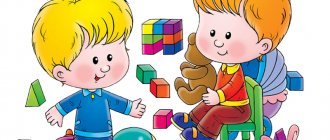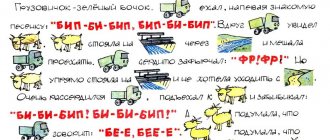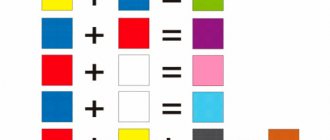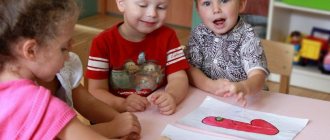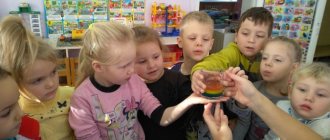Story pictures on speech development
In this section you can download ready-made sets of plot pictures for composing stories. Each set includes two or three pictures connected by a common plot or cause-and-effect relationships. Learning to compose stories based on one picture or a series of plot pictures promotes the development of coherent speech in children of preschool and primary school age. Looking at pictures develops a child's attention. By composing a story from pictures, the child develops thinking when he tries to understand their content, cause-and-effect, spatio-temporal, logical connections between the events depicted on them.
Download and print the assignment form. Cut it with scissors along the dotted lines. Ask your child to arrange the pictures into several sets, as logic dictates. After this, the child must determine the correct sequence of pictures for each set and compose a story based on them. But don’t rush to correct your child if, in your opinion, he has arranged the pictures incorrectly. Listen to his story first, maybe his logic will seem quite convincing to you. You should be alert if: 1. the child could not detect any connection between the pictures; 2. the child was often distracted from the topic of the story, did not highlight the “main” events, or there were many repetitions in the story; 3. the child only listed the objects in the pictures, used separate, short (non-extended) sentences; 4. The meanings of words were approximate; the child rarely used adjectives, adverbs, or words of a general nature.
ATTENTION!
All cards are prepared in pdf format. Typically, most computers already have the free Adobe Reader installed, which you can use to open and print the cards. If for some reason you do not have this program, please visit the ADOBE website here
Form 1
Download and print the assignment form. The form shows two pictures, for each of them the child must come up with and tell a short story.
Form 2
Download and print the assignment form. Cut it with scissors along the dotted lines. Ask your child to arrange the resulting cards into three sets (two cards in each set), as logic dictates. If a child makes a mistake, do not rush to correct him immediately, first listen to his version. After this, the child must determine the correct sequence of cards for each set and write a short story based on them.
Form 3
Download and print the assignment form. Cut it with scissors along the dotted lines. Ask your child to arrange the resulting cards into three sets (two cards in each set), as logic dictates. If a child makes a mistake, do not rush to correct him immediately, first listen to his version. After this, the child must determine the correct sequence of cards for each set and write a short story based on them.
Form 4
Download and print the assignment form. Cut it with scissors along the dotted lines. Ask your child to arrange the resulting cards into three sets (two cards in each set), as logic dictates. If a child makes a mistake, do not rush to correct him immediately, first listen to his version. After this, the child must determine the correct sequence of cards for each set and write a short story based on them.
Form 5
Download and print the assignment form. Cut it with scissors along the dotted lines. Ask your child to arrange the resulting cards into three sets (two cards in each set), as logic dictates. If a child makes a mistake, do not rush to correct him immediately, first listen to his version. After this, the child must determine the correct sequence of cards for each set and write a short story based on them.
Form 6
Download and print the assignment form. Cut it with scissors along the dotted lines. Ask your child to arrange the resulting cards into two sets (three cards in each set), as logic dictates. If a child makes a mistake, do not rush to correct him immediately, first listen to his version. After this, the child must determine the correct sequence of cards for each set and write a short story based on them.
Form 7
Download and print the assignment form. Cut it with scissors along the dotted lines. Ask your child to arrange the resulting cards into two sets (three cards in each set), as logic dictates. If a child makes a mistake, do not rush to correct him immediately, first listen to his version. After this, the child must determine the correct sequence of cards for each set and write a short story based on them.
Form 8
Download and print the assignment form. Cut it with scissors along the dotted lines. Ask your child to arrange the resulting cards into two sets (three cards in each set), as logic dictates. If a child makes a mistake, do not rush to correct him immediately, first listen to his version. After this, the child must determine the correct sequence of cards for each set and write a short story based on them.
Form 9
Download and print the assignment form. Cut it with scissors along the dotted lines. Ask your child to arrange the resulting cards into two sets (three cards in each set), as logic dictates. If a child makes a mistake, do not rush to correct him immediately, first listen to his version. After this, the child must determine the correct sequence of cards for each set and write a short story based on them.
Form 10
Download and print the assignment form. Cut it with scissors along the dotted lines. A series of pictures to establish spatial relationships between objects. To develop the ability to determine the position of an object in relation to another object. Pictures for the following spatial relationships: on, under, behind, in front, on the right, on the left.
Form 11
Download and print the assignment form. Cut it with scissors along the dotted lines. A series of pictures to establish spatial relationships between objects. To develop the ability to determine the position of an object in relation to another object. Pictures for the following spatial relationships: next to, in, behind, between, in front of, on.
CHILDHOOD GUIDE
In accordance with the Federal State Educational Standard for preschool education, the most relevant is the interaction between the teacher and children, which takes place in forms specific to preschoolers: in play, in cognitive and research activities, in the form of creative activity . The use of plot pictures just meets this requirement.
Working with story pictures is familiar to teachers as part of the speech development of preschool children. Traditionally, it happened like this: a series of pictures related by a single content was offered. Then questions were asked about the plot, characters, location, etc. After this, a story was compiled using the pictures.
The proposed methodology makes it possible to make interaction on speech development motivated and cognitive , which corresponds to the principles of developmental education. The proposed pictures must be connected by a single content; they depict the actions of the characters in a certain sequence. The objectives of this system of classes are to develop in children the ability to establish cause-and-effect relationships, develop speech and verbal creativity. By the way, similar educational games for children can be recommended to parents.
Tasks: 1. A set of pictures is offered in which the sequence is obviously broken . Children must find the mistake and correct it . Next, the task is given to tell the story using the pictures and come up with a title for the story. The task is to identify children’s ability to arrange the content of pictures in a logical sequence.
2. The entire series of pictures is exhibited. The first one is open , the rest are closed. It is proposed to use this arrangement to compose a short story (one picture at a time). After composing the story, the second picture opens , the children again come up with a story based on this location . the third picture opens (the actions are the same), then the fourth picture opens (the actions are the same). Children come up with a name, and the most successful one is chosen. The task is to develop imagination, the ability to foresee the development of the plot, the actions of the characters depicted in the first picture, and to develop the ability to come up with the most accurate title for the story.
3. A series of pictures is offered, which must be arranged in the correct sequence and a collective story must be compiled. The teacher asks who will start the story, who will tell the middle, who will finish. The task is to consolidate the idea of composition, develop the ability to act together, and help a friend in case of difficulty.
4. A series of four pictures is offered: the first three are closed, the last is open . Question: “What do you think could have happened here? Try to write a story when you know how the events ended.” One child talks about this arrangement. Then the first picture opens . The story is being invented again . After this, the middle pictures open . Collectively or one child makes up a story based on open pictures . A name is given and the best one is chosen. The task is to consolidate the idea of composition, develop imagination, and the logic of building a plot.
5. The teacher shows one picture , the children look at it. Then the child comes up with a story based on one picture . Question: “Can there be a continuation of this story? What could it be like? Then the entire series of 5 pictures is displayed . The first, third and fifth ones open The second and fourth are closed . children compose a story according to this arrangement . Then the second picture opens the story is composed again . The same actions with the fourth picture . A group of 5 people composes a new story . The task is to develop the ability to sense the logic of presentation and develop imagination.
6. The teacher displays a series of 4 pictures , the first and fourth are opened closed . Children come up with a story based on this arrangement (2 pictures) and give a name. Then all the pictures are opened and a story . The task is to consolidate the idea of the composition (the beginning and end are known, children guess what can be depicted in the middle).
Task options: 1. Play the game “Which picture is missing?” (children close their eyes, and the teacher hides one of the illustrations) or “Which one is missing?” 2. Play the game “Which pictures have swapped places?” 3. Distribute the pictures to the children and offer to display them on the display board at the right moment in the collective story. 4. Mix plot pictures for 2-3 familiar fairy tales, distribute them and offer to sort them into fairy tales in the correct sequence and tell them. 5. Distribute one illustration and determine the name of the fairy tale from it. 6. Give each child a picture for 2-3 fairy tales and read fragments from these fairy tales (children guess the passage and pick up the corresponding illustrations).
Thus , as part of developmental education , children perform various lexical and grammatical exercises aimed at developing the ability to compose simple and complex sentences, select synonyms and antonyms for given words, and connect parts of a statement.
Dear teachers! If you have questions about the topic of the article or have difficulties in working in this area, then write in the comments . I'll definitely help.
Golovina Bela Gennadievna, site administrator.
The importance of role-playing games in the social and moral development of preschoolers Educational situations in the musical development of preschoolers Visual modeling in the development of speech of preschoolers The priority of cultural values in the musical development of preschoolers >
